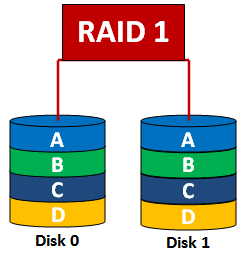RAID 1 - Mirroring

Data is stored twice by writing it to both the data drive and a mirror drive. If a drive fails, the controller uses either the data drive or the mirror drive for data recovery and continues operation. You need at least 2 drives for a RAID 1 array. There are advantages to a RAID 1. It is easy to implement, access to data is comparable to a single drive, and if one drive fails, there is a complete copy of the data. The disadvantages are that the system must be shut down and rebuilt in order to replace the failed drive and only half the capacity is available.
RAID 1 is a good solution for critical or irreplaceable data.
Data Recovery from a Failed RAID 1
Failure to get access to data with a RAID 1 usually means both drives have been compromised somehow. The good news is that we have two chances to recover the data. The bad news is that if the drives have not been closely watched, one drive can fail and the system will still work. This means one drive can have data is old and stale. There is no way to know which drive is stale until a full recovery is completed.
The first thing we do is assess each individual drive. Once the initial problem for each drive has been bypassed, we make a sector by sector clone of each drive using a tool specifically designed for this process. We then have access to data that can be tested for integrity and functionality. If we were able to recover data from both drives, we copy the most recent data and get it back to our client. If only one drive was recoverable and that drive is the stale data, it is sometimes better than having nothing.




